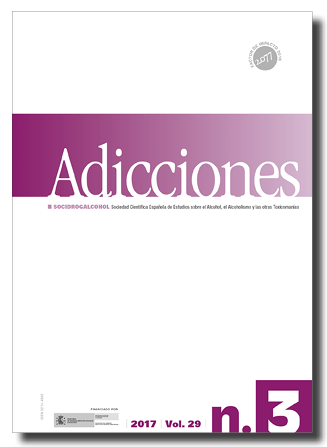Autoabandono del tabaco en una muestra española. Un estudio exploratorio
DOI:
https://doi.org/10.20882/adicciones.925Palabras clave:
autoabandono, flexibilidad psicológica, tabaquismo, autocontrolResumen
Se pretende realizar con el presente estudio, un análisis exploratorio de variables que puedan ayudar a explicar el éxito o fracaso en cesación tabáquica mediante autoabandono. El presente estudio obtuvo el informe favorable de la Comisión de Bioética de la Universidad de Almería, cuyo número de referencia es UALBIO2011/025. Los participantes del estudio se consiguieron mediante anuncios en prensa y radio y centros de salud, se les realizó una entrevista dirigida al registro de distintas variables relacionadas con el consumo de tabaco, edad de inicio, edad de abandono, años de uso del tabaco, número de cigarrillos al día y dependencia nicotínicaCitas
Bjartveit, K. y Tverdal, A. (2009a). Health consequences of sustained smoking cessation. Tobacco Control, 18, 197-205. doi:10.1136/tc.2008.026898.
Capafóns, A. (1989). Competencia aprendida-II- (La aproximación de Rosenbaum). Fiabilidad y validez de su medida. Crítica y recomendaciones. Revista Española de Terapia del Comportamiento, 7, 18-39.
Chiou, W., Wu, W. y Chang, M. (2013). Think abstractly, smoke less: A brief construal-level intervention can promote self-control, leading to reduced cigarette consumption among current smokers. Addiction, 108, 985-992. doi:10.1111/add.12100.
Gregor, K. y Borrelli, B. (2012). Barriers to quitting smoking among medically ill smokers. Journal of Behavioral Medicine, 35, 484-491. doi:10.1007/s10865-011-9376-y.
Lichtenstein, E. y Cohen, S. (1990). Prospective analysis of two modes of unaided smoking cessation. Health Education Research, 5, 63-72. doi:10.1093/her/5.1.63.
Raich, A., Martínez-Sánchez, J.M., Marquilles, E., Rubio, L., Fu, M. y Fernández, E. (2015). Smoking cessation after 12 months with multi-component therapy. Adicciones, 27, 37-46.
Roales-Nieto, J.G., San Pedro, E.M., García, R. C., Romero, B.M., López, F.J., Luciano, A. G., …López, M.H. (2016). Smoking self-quitting and psychological flexibility. International Journal of Psychology and Psychological Therapy, 25, 123-129.
Ruiz, F. J., Herrera, l. I. L., Luciano, C., Cangas, A. J. y Beltrn, I. (2013). Measuring experiential avoidance and psychological inflexibility: The spanish version of the acceptance and action questionnaire-II. Psicothema, 25, 123-129.
Schachter, S. (1990). ‘Debunking myths about self-quitting: Evidence from 10 prospective studies of persons who attempt to quit smoking by themselves’: Reply. American Psychologist, 45, 1389-1390. doi:10.1037/0003-066X.45.12.1389.
Smith, A. L., Chapman, S. y Dunlop, S. M. (2015). What do we know about unassisted smoking cessation in Australia? A systematic review, 2005-2012. Tobacco Control, 24, 18-27. doi:10.1136/tobaccocontrol-2013-051019.
Thomsen, T., Villebro, N. y Mller, A. M. (2014). Interventions for preoperative smoking cessation. The Cochrane Database of Systematic Reviews, (3), CD002294. doi:10.1002/14651858.CD002294.pub4.








